The best DSLR adapter alignment solutions for scientific photography include precision T-ring adapters, adjustable collar systems, microscope-specific mounts, tilt-correction platforms, and calibrated alignment tools. You’ll also benefit from quick-release mounting plates, center-weight balancing systems, compensating spacer rings, and variable tension mounts with perpendicularity control. These solutions guarantee your sensor stays perfectly aligned with the optical plane, eliminating distortion and maintaining consistent focus across your entire image field. Discover how these precision tools transform your scientific imaging capabilities.
Precision T-Ring Adapters With Multi-Point Alignment
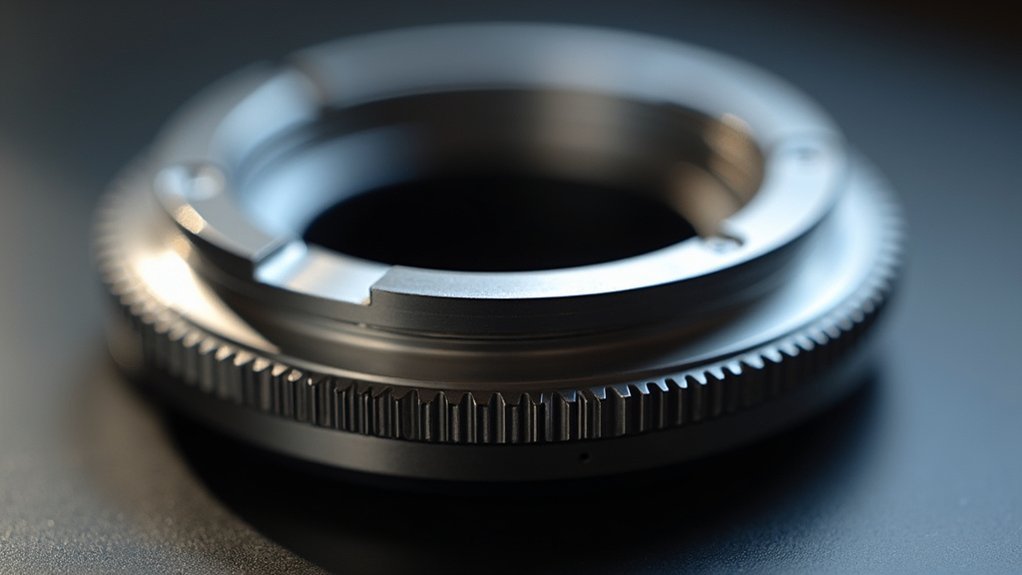
The heart of any successful astrophotography setup lies in proper alignment between your DSLR camera and telescope. Quality T-ring adapters, like the TeleVue Standard model, guarantee this critical alignment for ideal results in your celestial imaging.
Precise camera-telescope alignment remains the cornerstone of exceptional astrophotography, achievable only through professional-grade T-ring adapters.
When selecting a T-ring adapter, look for those featuring multi-point alignment capabilities. These sophisticated designs allow you to make fine adjustments that greatly improve focus accuracy and reduce image distortion.
Camera-specific models, whether for Canon EOS or Nikon systems, provide enhanced compatibility with your telescope configuration.
For perfect backfocus adjustment, you can pair your T-ring with Astro-Tech T-thread spacer rings to prevent vignetting. The precision machining and durable materials found in high-quality adapters deliver consistent performance and reliability throughout years of scientific photography sessions.
Adjustable Collar Systems for Optimal Sensor Positioning
Adjustable collar systems offer you micron-precision rotational adjustments that eliminate subtle misalignments between your camera’s sensor and the telescope’s optical plane.
Multi-axis mounting platforms complement these collars by allowing fine-tuning across multiple planes, ensuring your imaging train maintains perfect perpendicularity to incoming light.
The integration of quick-release bayonet mechanisms lets you swap cameras without losing your carefully calibrated position, saving precious time during limited astronomical viewing windows.
Micron-Precision Rotational Adjustment
Precision engineering allows modern DSLR adapter collar systems to achieve rotational adjustments at the micron level—specifically within 0.45 microns per revolution. You’ll find these micron-precision rotational adjustment systems essential for astrophotography where even slight misalignments can ruin your image quality.
| Adjustment Type | Precision Level | Primary Benefit |
|---|---|---|
| Fine Rotation | 0.45μm/rev | Ideal focus |
| Tilt Control | 1-5μm | Reduces coma |
| Lateral Shift | 2-10μm | Centers image |
| Collar Lock | <1μm slippage | Stability |
| Digital Readout | 0.1μm tracking | Repeatability |
When working with telescopes like the Edge HD at f/7, you’re managing a critical focus zone of just 65-100 microns. The digital scales on premium systems let you track settings precisely, ensuring consistent results across multiple imaging sessions.
Multi-Axis Mounting Platforms
When you’re pursuing perfect astro-images, multi-axis mounting platforms become your critical alignment ally, offering independent adjustments across several planes simultaneously.
These adjustable collar systems let you fine-tune your DSLR’s position with micron-level precision, greatly reducing optical distortions that plague less sophisticated setups.
- Lockable axis adjustments guarantee your carefully aligned position stays put during long exposures
- Graduated scales on multi-axis platforms enable repeatable setups for consistent results across sessions
- Compatible with various camera adapters and telescope systems for maximum versatility
- Noticeably improves focus accuracy by allowing precise sensor positioning relative to the optical path
- Reduces critical focus zone (CFZ) issues through proper perpendicular alignment to the light path
You’ll find these systems particularly valuable when shifting between different imaging targets or when absolute precision is non-negotiable.
Quick-Release Bayonet Mechanisms
The frustration of constantly realigning your telescope setup dissolves with quick-release bayonet mechanisms, which revolutionize how astrophotographers connect cameras to optical systems.
These mechanisms enable you to attach your DSLR to telescopes securely and efficiently, dramatically reducing setup time during critical observation windows.
When paired with adjustable collar systems, you’ll achieve precise sensor positioning relative to the telescope’s focal plane.
These collars feature fine-tuning capabilities that let you optimize alignment and lock your settings in place, ensuring consistent results across multiple imaging sessions.
The stability provided by high-quality quick-release bayonet mechanisms is particularly valuable during long-exposure photography, where even minimal camera movement can ruin hours of work.
You’ll appreciate the seamless shift between different imaging configurations without sacrificing the precision your scientific photography demands.
Microscope-Specific DSLR Mounting Solutions
You’ll find two primary methods for attaching your DSLR to a microscope: eyepiece coupling systems that replace or attach to the eyepiece, and trinocular port adapters that connect directly to a dedicated camera port.
Eyepiece couplers work well for basic setups but may introduce vignetting if not properly matched to your camera’s sensor size.
Trinocular port adapters typically offer superior alignment and full-frame imaging, making them worth the additional investment for professional microscopy photography.
Eyepiece Coupling Systems
Microscope enthusiasts seeking to document specimens with professional-quality images will find eyepiece coupling systems indispensable for connecting DSLR cameras to microscopes.
These adapters create a direct optical path that maximizes image quality and resolution.
- Your DSLR will attach securely via a T-Ring designed specifically for your camera model.
- The standardized T-thread interface guarantees compatibility across various microscope brands.
- You’ll need to precisely align your camera’s sensor with the microscope’s optical axis for sharp results.
- Most systems include adjustable spacers to fine-tune the distance between camera and eyepiece.
- Proper alignment through these coupling systems eliminates vignetting and guarantees even illumination.
When selecting an eyepiece coupling system, you’ll benefit from models that offer fine adjustment capabilities, allowing you to achieve perfect focus for your scientific photography needs.
Trinocular Port Adapters
When seeking precision in microscopic photography, trinocular port adapters offer a dedicated mounting solution that eliminates many alignment challenges photographers face with eyepiece couplers.
These specialized camera adapters connect directly to your DSLR via T-threads that attach to your camera’s T-ring, ensuring ideal light transmission from microscope to sensor.
You’ll appreciate how these adapters precisely align with the microscope’s optical path, delivering superior photomicrography results.
Most models feature adjustable components to accommodate various DSLR configurations, maximizing your equipment versatility.
Look for adapters with built-in optics that reduce vignetting and enhance image clarity—critical factors for scientific documentation.
Constructed from durable aluminum, quality trinocular port adapters provide the stability needed for extended laboratory use, making them a worthwhile investment for serious scientific photographers who can’t compromise on image quality.
Universal Tilt-Correction Platforms for Scientific Imaging
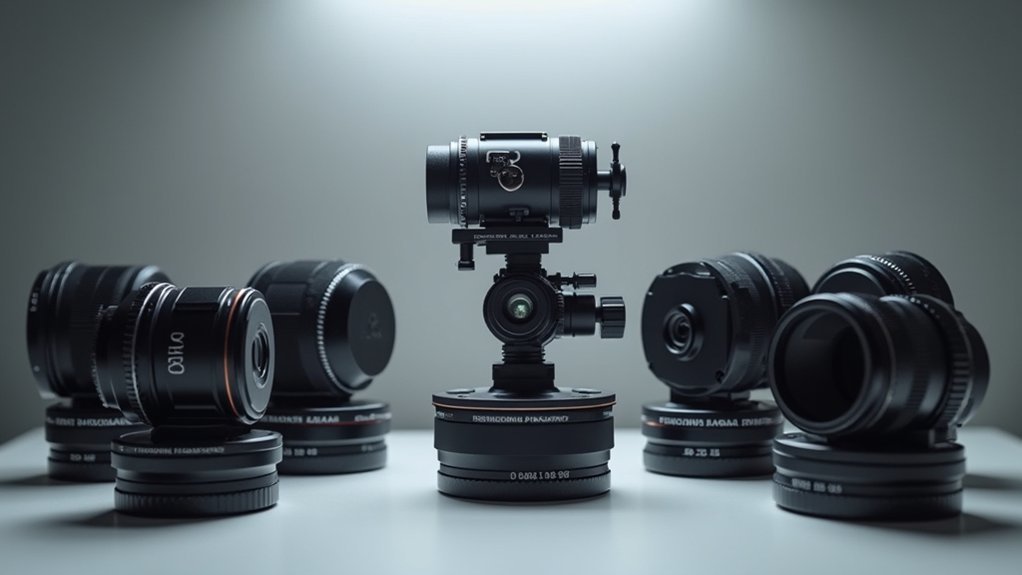
Although often overlooked in scientific imaging setups, universal tilt-correction platforms serve as critical components for achieving perfect optical alignment between your camera and the subject.
When working with high-performance optical systems, you’ll need precise adjustments to maintain the critical focus zone of just 65-100 microns.
- Baader M68 Tilter offers excellent value at $275 with robust alignment capabilities
- Astrodevice Tilt Corrector provides effective adjustments despite its 3D printed construction
- Understanding your system’s CFZ is essential for proper tilt-correction implementation
- Software tools like ASTAP deliver immediate feedback on your alignment adjustments
- Proper tilt-correction greatly enhances image quality by ensuring your camera sensor aligns perfectly with the optical axis
Calibrated Camera Alignment Tools for Laboratory Photography
Precision sensor adjustment tools revolutionize your laboratory photography by enabling micrometer-level camera positioning relative to optical instruments.
You’ll find tilt calibration methods essential when working with flat specimens where even sub-millimeter misalignments can compromise data integrity.
Micro-positioning camera systems offer the advantage of repeatable setups, allowing you to maintain consistent imaging parameters across multiple experimental sessions.
Precision Sensor Adjustment Tools
For ideal laboratory and scientific photography, your DSLR’s sensor must align perfectly with optical equipment. When capturing microscopic specimens or distant celestial objects, precision T-Ring adapters guarantee your camera maintains proper alignment with telescopes and microscopes, delivering sharper images and more accurate scientific data.
- High-quality T-Ring adapters designed specifically for your Canon or Nikon camera eliminate compatibility issues.
- Adjustable spacer rings maintain the critical backfocus distance between sensor and optical elements.
- Tilt adjusters allow fine-tuning to correct misalignment issues that can degrade image quality.
- Precision measurement software like NINA helps you monitor and adjust sensor tilt in real-time.
- Properly aligned sensors maximize your critical focus zone (CFZ), essential for capturing minute details in scientific specimens.
Tilt Calibration Methods
When misalignments occur between your DSLR sensor and optical equipment, even minor tilt issues can greatly degrade image quality, especially in high-precision laboratory photography.
Achieving ideal focus across your entire image field requires methodical calibration techniques. Start by utilizing tilt adjusters that allow for fine-tuning at micron-level precision. Keep detailed notes of all adjustments, documenting each change to track your progress.
For systems like Edge HD at F/7, you’ll need to work within a critical focus zone of 65-100 microns. Software solutions like ASTAP provide immediate feedback on focus quality, helping you make informed decisions during calibration.
After each adjustment, capture test images to verify improvements. This systematic approach guarantees your sensor plane remains parallel to the focal plane, delivering the sharpest possible results.
Micro-Positioning Camera Systems
Achieving laboratory-grade photographic precision requires dedicated micro-positioning camera systems that operate at sub-micron scales.
You’ll need calibrated alignment tools like T-Ring adapters and spacer rings to optimize the distance between your camera and telescope or microscope, ensuring perfect focus in scientific applications.
- ZWO ASIAIR systems provide real-time feedback on your alignment adjustments
- ASTAP software monitors tilt and focus, keeping your camera within the critical focus zone
- Carbon fiber mounting solutions minimize vibrations during long exposures
- Precision spacer rings allow for fine-tuning the camera-to-telescope distance
- Sub-micron adjustment mechanisms enable you to capture the smallest details with clarity
These positioning systems transform ordinary DSLR cameras into laboratory-grade imaging tools, giving you the precision needed for scientific photography without compromising image quality.
Micrometer-Adjusted Optical Axis Adapters
While standard camera adapters connect DSLRs to telescopes, micrometer-adjusted optical axis adapters take precision to an entirely new level.
These specialized tools allow you to fine-tune your camera’s alignment within microns, ensuring perfect optical path configuration for your astrophotography sessions.
You’ll appreciate the graduated scales that enable exact measurements for critical focus and tilt corrections. When capturing celestial objects, these minute adjustments make a considerable difference in your final image quality.
The high-quality materials used in these adapters provide exceptional stability and durability during long exposure sessions, preventing unwanted shifts.
Whether you’re using different telescope models or switching between equipment setups, these versatile adapters maintain compatibility across various systems.
Quick-Release Precision Mounting Plates for Consistent Results
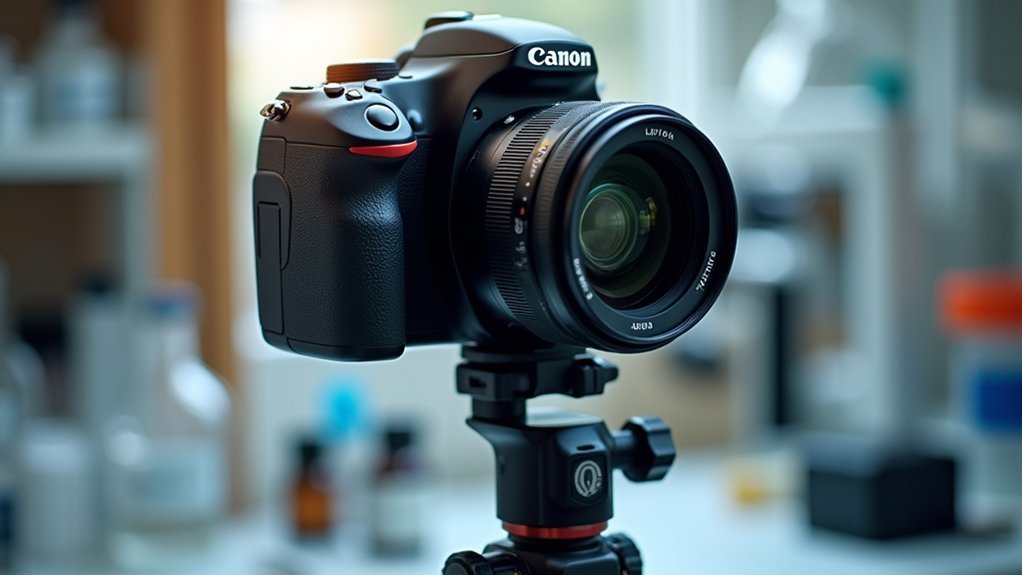
Precision mounting plates with quick-release functionality represent a game-changer for serious astrophotographers who need both accuracy and efficiency.
You’ll find these specialized adapters provide the perfect balance between speed and precision when connecting your DSLR to telescopes for scientific imaging.
- Adjustable tilt mechanisms allow you to fine-tune camera positioning, reducing distortion and optimizing focus
- Standard T-thread or Vixen-style compatibility guarantees you can use them with virtually any telescope setup
- Lightweight aluminum construction adds minimal weight while maintaining essential stability during exposures
- Built-in leveling features help you achieve precise orientation for accurate celestial target framing
- Rapid attachment/detachment capability means you won’t miss critical imaging opportunities when conditions change
These quick-release precision mounting plates deliver consistent alignment shot after shot, making them an indispensable tool in your astrophotography arsenal.
Center-Weight Balancing Systems for Stable Microscope Connections
When your DSLR connects to a microscope, proper balance becomes critical for capturing clear, vibration-free images. Center-weight balancing systems counteract your camera’s mass, ensuring perfect alignment with the microscope’s optical path while minimizing unwanted movement.
You’ll find these stabilization solutions equally valuable for telescope setups, where precision is paramount for astrophotography.
| Feature | Benefit |
|---|---|
| Adjustable weights | Customizable balance for different camera models |
| Quick-release plates | Efficient workflow between experiments |
| Calibration controls | Fine-tuning for ideal focus alignment |
Compensating Spacer Rings for Parfocal Imaging
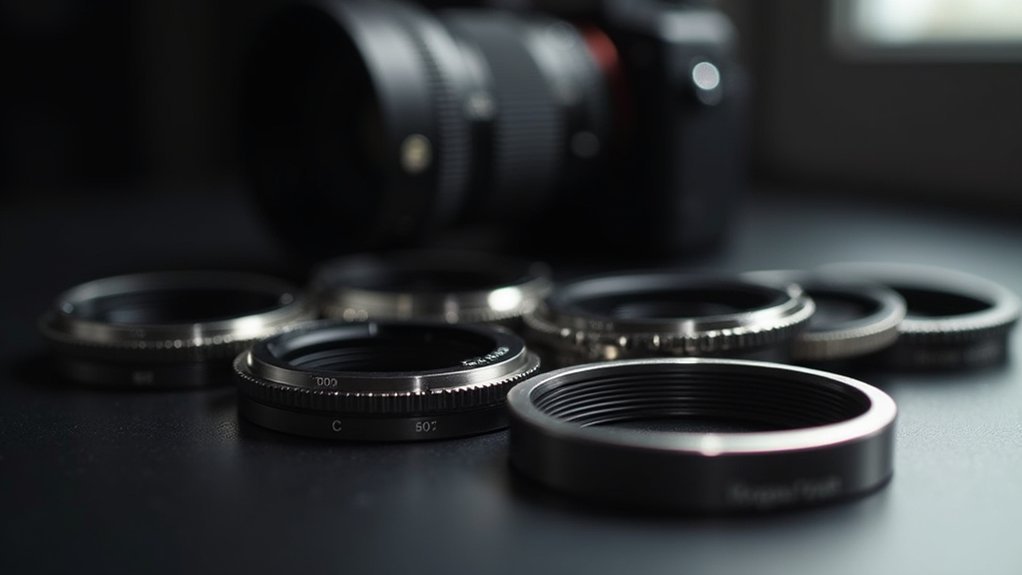
To achieve perfect parfocal imaging across your optical system, compensating spacer rings serve as the critical link between your DSLR’s sensor and the focal plane.
These precision components guarantee your camera maintains proper alignment, greatly enhancing image sharpness and reducing vignetting.
- Astro-Tech offers T-thread spacer rings in 5mm, 10mm, 20mm, and 30mm sizes—all at $9.95
- Even minor adjustments with compensating spacer rings can dramatically impact your critical focus zone
- Fast optical systems like Edge HD at f/7 require particularly careful tuning of backfocus
- You’ll experience minimal refocusing when switching between eyepieces or imaging devices
- Proper sensor positioning through spacer rings helps eliminate focus discrepancies across the image field
Variable Tension Adapter Mounts With Perpendicularity Control
Perfect alignment between your camera sensor and optical axis determines whether your images appear uniformly sharp or frustratingly distorted. Variable tension adapter mounts offer the precise adjustments you need for scientific photography excellence.
These specialized mounts feature adjustable tension mechanisms that let you fine-tune your camera’s position to achieve perfect perpendicularity to the optical axis. You’ll minimize optical aberrations and maintain consistent focus across the entire image field—critical for detailed scientific observations.
Most variable tension adapter mounts are compatible with standard T-ring connections, accommodating both DSLR and mirrorless cameras. Their high-quality construction guarantees stability during long exposure sessions, while the perpendicularity control helps eliminate distortion that can compromise scientific data.
For reliable performance in demanding imaging scenarios, these mounts are indispensable tools.
Frequently Asked Questions
Can Budget Adapters Achieve Professional-Quality Scientific Photography Results?
Budget adapters can deliver professional scientific results if you’re careful with alignment and stability. You’ll need to compensate with proper technique and potentially minor post-processing to overcome their mechanical limitations compared to premium options.
How Often Should Alignment Systems Be Recalibrated for Optimal Performance?
You should recalibrate alignment systems after every major transport, temperature change, or 3-6 months of regular use. Weekly checks help maintain precision, but your specific imaging requirements may dictate more frequent calibration schedules.
Are Wireless Control Options Available for Remote Scientific Photography?
Yes, you’ll find numerous wireless control options for remote scientific photography. WiFi adapters, Bluetooth triggers, smartphone apps, and dedicated remote controllers let you operate cameras from a distance without disturbing sensitive equipment or specimens.
What Maintenance Procedures Extend the Lifespan of Precision Adapters?
To extend your precision adapters’ lifespan, you’ll need regular cleaning with microfiber cloths, proper storage in dry environments, periodic lubrication of moving parts, and inspection for alignment issues. Don’t overtighten connections when mounting equipment.
Do Weather Conditions Affect Adapter Alignment in Outdoor Scientific Photography?
Yes, weather conditions greatly impact your adapter alignment outdoors. Temperature fluctuations cause thermal expansion, humidity can corrode components, and wind vibrations disrupt stability. You’ll need weather-appropriate protection and more frequent field calibrations.
In Summary
Selecting the right DSLR adapter alignment solution will transform your scientific photography results. You’ll achieve perfect sensor alignment, consistent focal positioning, and eliminate unwanted artifacts. Whether you’re working with microscopes or specialized laboratory setups, these ten solutions help you overcome common alignment challenges. Invest in the right adapter system and you’ll spend less time troubleshooting and more time capturing the precise scientific images you need.

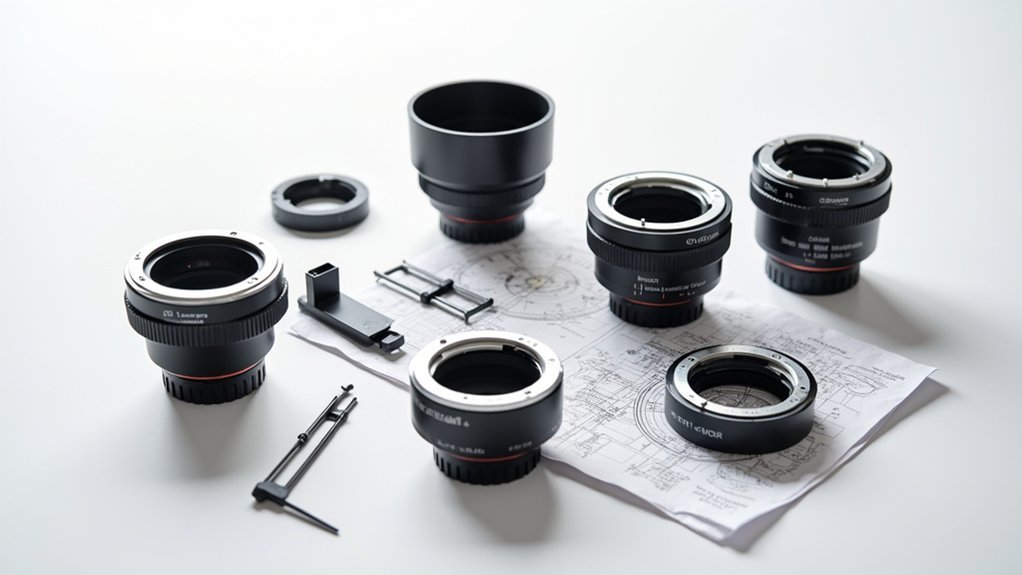



Leave a Reply